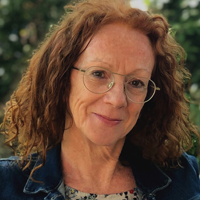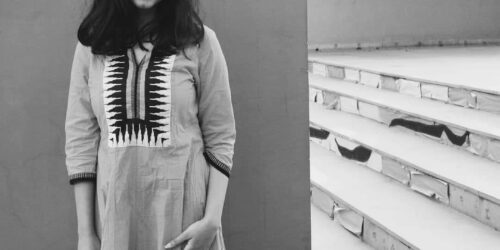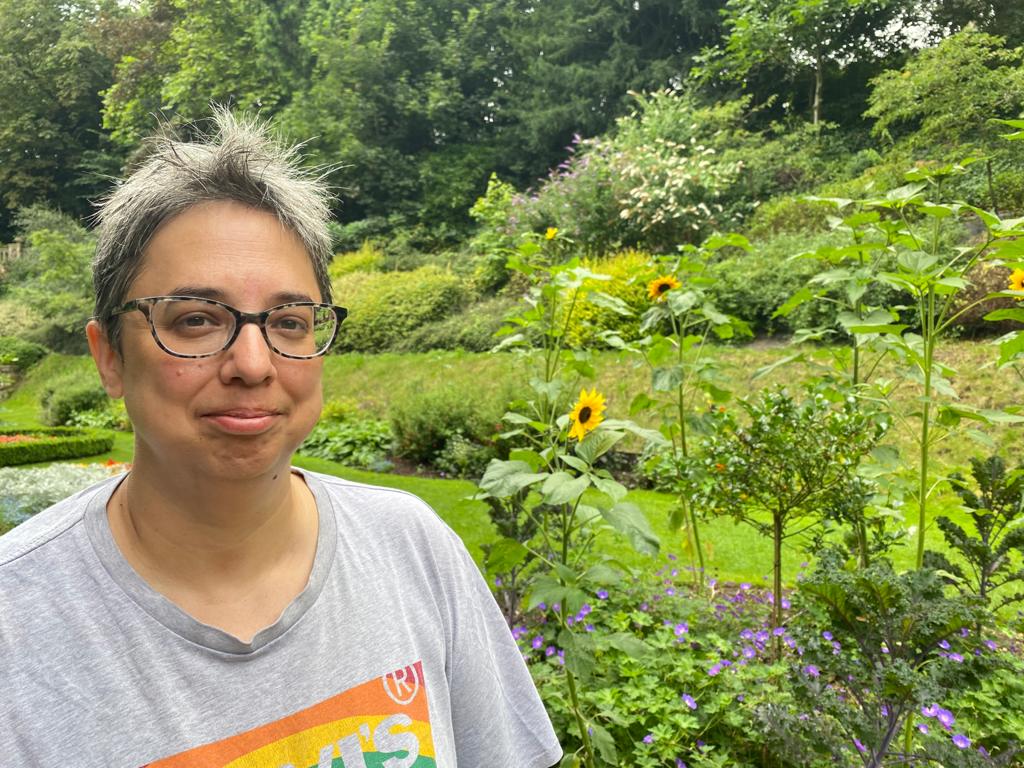
In August 2021, we were delighted to welcome Louise Tondeur to National Centre for Writing at Dragon Hall. While she was with us, she devised a series of accessible walks, all with Dragon Hall as the starting point.
Part of our Walking Norwich series.
Last summer I had a residency in the cottage at Dragon Hall, home to the National Centre for Writing. I was editing my next novel, which is set partly in Norwich, and researching an idea for a postapocalyptic story that I kept returning to and then leaving for a while – not unlike my relationship with the city.
My first experience of Norwich was the newly opened Puppet Theatre; my grandpa took my brother and me when I was seven or eight. Then I lived in Norwich for four years as an undergraduate student and commuted here for two as a postgraduate, always feeling like a visitor, although I knew parts of East Anglia, as my grandparents lived on the Norfolk Suffolk border from the early seventies. Writing about a place from a distance is notorious: it’s easy for the details to become clouded by nostalgia and emotion memory, and for the distances between things to shrink.
Some places I’m writing about I never visited as a student, like St. Julian’s church and the Plantation Gardens. As for the familiar places, like Chapelfield Gardens, the rivers, and UEA, I needed to check my memories against experience, to note the specific details, to have a sensory involvement in each of them.
As I explored Norwich again, I wanted to contribute to the National Centre for Writing, and thought it would be useful to leave behind a series of accessible walks for writers like me who can’t walk long distances easily. I see walking as part of my writing process but walking for more than about 20 minutes is painful. I’m coming at this series of blog post from the point of view of a writer who needs to walk but finds it difficult.
What the walks in the resulting series have in common is that they use Dragon Hall as a hub, are accessible, and wheel-chair friendly, but also that they include a stop for writing along the way.
I use a technique I call ‘live writing’ to write about place. That means writing while I am in a place, sometimes spending a day on location. I use freewriting to do so, writing without editing. Usually, I keep going until a couple of interesting characters emerge and talk to each other, then edit at home.
Live writing means being thoroughly caught up in a place, immersing myself in it and engaging with it on a sensory level.
That’s how I wrote the stories in my collection Unusual Places, two of which are set partly in Norwich. I don’t always write about the place in a factual or literal way, rather I use the place to inspire the story. For me, Live Writing means being thoroughly caught up in a place, immersing myself in it and engaging with it on a sensory level. If I were to analyse it, I’d say I was using the objective correlative, imbuing the scene with emotion.
Although it might look deceptively like sitting on a bench and writing in a notebook, writing live involves a mindful engagement with the environment, noticing the veins on a leaf, or contrasting smells or textures, or the pleasing and jarring sounds, or the change in temperature as you enter a cathedral. It is a kind of mindfulness but more than that it’s like responding to hundreds of writing prompts at once.
Most of the walks build on one another. For instance, you could go from the river to the train station, take a bus to Chapelfield, and from there walk to the Plantation Gardens, then continue the bus journey to UEA and walk down to the Sainsbury Centre.
St. Julian’s Garden
I have come to St. Julian’s church to write. I am facing what used to be one of the busiest streets in Norwich; ironic because St. Julian’s Garden feels like a secret find, a hidden nook away from, but close to, the busyness of the city. It also feels unusual because it isn’t obviously a graveyard. Julian of Norwich was a writer, so it’s fitting that there are several places where you can sit down and write here.
It is high summer, and the grass is littered with pinecones. I am sitting on a rickety bench, stained by moss. In front of me is a horse chestnut tree, several fir trees and what could be an ash tree. Not knowing the names of trees bothers me, because in my imagination they have personalities, and this is their place; I’m only visiting. The wind has a particular way of whispering through what I think are ash trees. I have seen more of them at the University of East Anglia, lots of them, more mature, and I want to call them by name, but the information slips through my fingers like sand.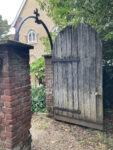
When I first wrote about St Julian’s, two characters watched a suspicious (and fictitious) community centre over the road, from behind a gate in a low wall. But the wall is as tall as me, the gate taller, and off to the side. They wouldn’t be able to see the place I wanted them to watch from here; in fact, it would make a much better hiding place than I had imagined, although if they wanted to get in here after dark, they would need a key.
Yes, I could fictionalise the churchyard too, but I want to be true to it: the flint walls of the church, the red brick wall leading to the arched wooden gate, the surprising number of mature trees, roses, poppies and what I think might be fuchsias.
As well as the absence of gravestones, when writing from a distance it is difficult get proportions and relative sizes right, to see how everything fits together, and hard to imagine the sounds and smells, how crowded it might be, how lonely, whether there’s a sense of foreboding or of tranquillity or excitement, which is why I’ve come.
I can hear the muted sounds of today’s city around me, but I can also sense the hustle and busyness of King Street as it used to be 650 years ago: the smell of the river and of animals, market stallholders selling their wares, the chanting of nuns, the tolling of the church bell. Julian herself might have felt like another regular sight if you had passed along King Street regularly, available for blessings.
I can hear the muted sounds of today’s city around me, but I can also sense the hustle and busyness of King Street as it used to be 650 years ago.
In the garden all that history is still here underneath the rebuilt church and modern housing; the voices louder and closer, the tower with its bell open to the elements, the one intriguing grave, below a crucifix on a tree (perhaps another ash), but whose is it?
A common theme I’ve noticed with all my visits to places to write is that I often get little information about the place itself during the visit. Official information is available, yes, but not detail, and not answers to specific questions. On the days I visit St. Julian’s, there isn’t anyone to ask, aside from the trees, who aren’t giving up their secrets easily.
St. Julian’s is a five-minute walk from Dragon Hall, up a gentle incline along St. Julian’s ally, and clearly signposted. The gate to the garden is on your left as you approach the church.
The River Wensum
Down by the river Wensum, the weeping willows, and their reflections in the water, are one of my most abiding memories of being a student in Norwich, possibly because they are near the train station and signified arriving and departing. Weeping willows are also emblematic of the land meeting the water, a liminal space, and an idea I’ve been exploring since I wrote my first novel The Water’s Edge, which I finished while studying in Norwich, over twenty years ago.
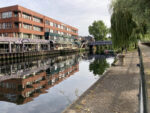 I walk along the river, and sit opposite whispering trees, also reflected in the water, near an old boat; canoeists pass me, swans, and sunburnt captains of river cruisers. Here the decrepit benches, the birds and trees, the litter from late-night revellers and water itself provide a contrast in sense impressions, making it an excellent location for writing outside. Also good because of the number of places to take shelter if the weather threatens, although to find a café rather than a pub or restaurant, you are better off going back to King Street.
I walk along the river, and sit opposite whispering trees, also reflected in the water, near an old boat; canoeists pass me, swans, and sunburnt captains of river cruisers. Here the decrepit benches, the birds and trees, the litter from late-night revellers and water itself provide a contrast in sense impressions, making it an excellent location for writing outside. Also good because of the number of places to take shelter if the weather threatens, although to find a café rather than a pub or restaurant, you are better off going back to King Street.
This is where I came to ponder the draft of the novel I had just finished when I was on a writing retreat at Dragon Hall. From Lady Julian bridge I could see the Waterfront where I started my career as a Drama Student at UEA in the 90s. So this short walk represents my own personal journey, but also the expansion of Norwich itself: the riverside development and the Writers’ Centre were yet to be established in those days. Prior to Thorpe Station being opened in 1844, the area behind me was meadowland.
Like the other visits I’ve made in Norwich to write, this is somewhere I can meet with myself, a trysting place, with the noises of the city around me, chatter and chinking glasses at the pub near-by, shouting, children crying, a wood pigeon cooing, building work, rustling trees, rumbling buses and traffic, and I can still find peace here, I can still find a place where the land meets the water, a form of meditation and a way of practising mindfulness.
I can still find a place where the land meets the water, a form of meditation and a way of practising mindfulness.
Mulling things over without knowing what I am meant to think about is important to me as a writer and often I’m drawn to water to do that. Seek out water seems like odd writing advice, but it’s useful because the river is older than me, like the trees, a reminder of permanence and impermanence at the same time.
Of course, Dragon Hall was there, down the road, when I performed at the Waterfront in 1991 – it simply hadn’t become host to the Writers’ Centre yet. There may have been no restaurants in those days, and Castle Meadow shopping mall (about a 15-minute walk along King Street from Dragon Hall) existed on paper only, but the river had already told a thousand stories, connected a thousand lives, and journeys had crisscrossed one another here for years. Sitting by the river I’m only a tiny part of those stories, but I’m still part of them.
From Dragon Hall, head down to the river. Carry on over Lady Julian Bridge, then walk along the river behind the restaurants. There are benches here where you can write. This will take you about 10 minutes.
For step-free access to the riverside, once you have crossed the bridge, go down the slope to the river on the Weatherspoon’s side and walk under the bridge.
Follow Jon McGregor’s walk along the river →
Chapelfield Gardens
I killed someone in Chapelfield Gardens on a different day from today; today the trees are so laden with leaves, it’s hard to see from one side of the park to the other. As I write this I’m in the midst of picnickers, young people on a break from school making the most of the swing tyre, joggers, parents with pushchairs, dog walkers, kids singing to their phones, Deliveroo cyclists taking a shortcut. Today the park feels like an island oasis, with traffic, police cars and buses passing by behind me. It’s one of the hottest days of the year, which seems to slow everything down: sounds of laughter, a dog escaping its lead, traffic, chatting.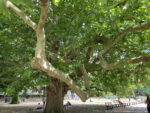
On the day I killed him, snow had fallen thickly; the trees were bare, it was freezing cold, too cold to be out in the middle of the night; nobody was around, and all but one of the lamps had given out, and that was flickering ominously. Today, it’s almost impossible to imagine the trees without leaves, the people gone, the ground frozen; it feels as if it will always be like this: what Buddhists call the illusion of permanence.
It feels as if it will always be like this: what Buddhists call the illusion of permanence.
One thing that’s noticeable from pausing to write in Chapelfield Gardens is that this is both a meeting place and a crossroads. It’s a place people pass through; their trajectories crisscross with one another. Imagine you could trace their journeys through the city: like a tube map, but made up of myriad walks across Norwich in different colours, of different textures, some determined, some fast, runs rather than walks, some on wheels, some difficult, painful, some thoughtful, some without much thought, some with coffee, some with a purpose, some just for the sake of it.
Chapelfield Gardens is also a meeting place: somewhere people meet with themselves, a concept I’ve heard called a ‘trysting place’. Several people pause here on benches, on their lunchbreak, or just because. Writers need to meet with themselves, to find trysting places from time to time – sometimes with a purpose (have I really got that description of the bandstand right from memory?) sometimes to let our minds mull things over or to take seriously the idea that we are observers of the world, and sometimes just for the sake of it.
I wonder how old the trees are, and what they’ve seen. The character who dies on the bandstand died waiting for someone who didn’t turn up, and the trees are performing the ultimate wait: through the seasons, through momentous events, through the everyday, often ignored, but watching everyone.
Photos don’t capture the essence; it takes other senses too.
I was recalling Norwich from a distance when I killed the character on the bandstand; I couldn’t remember the details; the muted browns and greens I knew, and the paths crossing the park, but not the specifics. Photos don’t capture the essence; it takes other senses too, as I’ve discovered by meeting with myself in this trysting place today.
From Dragon Hall, walk over Lady Julian bridge, through the riverside restaurants and on to the train station. This takes about 10 minutes.
Take either the number 25 or 26 bus from the station, get off at Red Lion Street and walk up Theatre Street, past St. Stephen’s church and the Theatre Royal, and on to the gardens, about a 10-minute walk. There are plenty of places to sit and write. To avoid the hill, stay on the bus to the first stop on Earlham Road (26) or Unthank Road (25) and walk back towards the park. This walk combines well with a visit to the Plantation Gardens on Earlham Road.
Plantation Gardens
It felt odd walking into the Plantation Gardens close to where I lived as a third-year undergraduate at UEA, that I had destroyed in a post-apocalyptic story I was writing, but which I had never visited. A fellow tutor at the Open University agreed to take me there by car and to show me around. Her first question was an obvious one if you know someone is writing about a place: what are you writing and why are the gardens important? I had to admit to myself that I had wanted to visit them for such a long time that my curiosity about the gardens now outstripped the actual reason I needed to look at them for the story. The plantation gardens were intriguing; the fact I had lived around the corner and never been made them seem secret and exotic.
I had to answer my friend’s question, rather embarrassingly, by saying that I had been writing about the gardens as if they were in ruins, and I needed to work out what would happen to them if a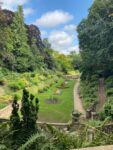 meteor struck the earth twenty miles away. I hadn’t appreciated how bowl-like they were from looking online. My friend and I figured they would flood, if disaster struck. In my imagination, they seemed rather beautiful underwater, ethereal even, including broken bits of the cathedral surrounded by weeds and fish.
meteor struck the earth twenty miles away. I hadn’t appreciated how bowl-like they were from looking online. My friend and I figured they would flood, if disaster struck. In my imagination, they seemed rather beautiful underwater, ethereal even, including broken bits of the cathedral surrounded by weeds and fish.
My first un-virtual visit to the gardens, then, had me imagining swimming around the Arthurian fountain like a mermaid and gliding on my back towards where steps climb up the steep sides of the gardens today. I felt guilty. I seemed to be working my way around Norwich murdering characters and demolishing buildings, including both cathedrals and the university. The secondary effect was that as I subsequently wrote about the gardens remotely from home, I remembered them as more watery than they actually are, with a mermaid’s eye view, as it were.
I seemed to be working my way around Norwich murdering characters and demolishing buildings.
My visit to the gardens wasn’t so that I could represent them authentically, but so that I could work out how to manipulate them and I worried about offending readers. Standing in the Plantation Gardens, I started to doubt myself.
Hadn’t I made out that I wanted to visit Norwich to research my book in a positive, respectful way? Was I allowed to do what I wanted with it? How much power does a writer have? Am I allowed to destroy large parts of East Anglia? Including the places that were so significant to me when I was younger, and the places that were precious to other people who had lived their lives in the city I only stayed in for a few years?
The funny thing is that ‘apocalypse’ originally meant revelation, to uncover something hidden, or to lay bare a secret. I’m not claiming that my walk in the plantation gardens was biblical, but it was definitely a revelation, especially when I finally allowed myself to feel uncertain and to process the feeling and to keep writing anyway.
From Dragon Hall, walk over Lady Julian bridge to the train station. This takes about ten minutes. Take the number 26 bus to the Roman Catholic Cathedral on Earlham Road (a 20-minute ride). From there it’s a short walk into the Plantation Gardens.
The entrance is on the same side of the road as the Cathedral. Once you’ve paid to get in (£2 when I went in summer 2021) take a short walk into the basin of the gardens. This will take about 5 minutes from the bus stop.
Read about Kim Heayeon’s walk to Plantation Gardens →
The Sainsbury Centre
As an undergraduate, I heard many inspiring writers read from their work as part of the University of East Anglia’s writers’ series. I came face-to-face with the Giacometti sculptures I had studied for A-level at the Sainsbury centre. I started writing prose there, on a bench down by the lake, as a nineteen-year-old. I came out at UEA and met my wife there. A few years later I sold my first novel after winning a prize as a postgraduate.
All of those things gave me the confidence to keep writing, and that’s only a brief snippet of the way UEA has inspired me. For me it was a crucible, suggesting possibilities, but my experiences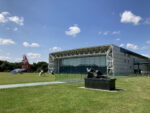 came with the difficulties you might expect with any challenge. So instead of writing about UEA generally, I’ll talk about how UEA has inspired me as a landscape.
came with the difficulties you might expect with any challenge. So instead of writing about UEA generally, I’ll talk about how UEA has inspired me as a landscape.
One of the characters in the post-apocalyptic story I’m writing walks along the Earlham Road, across campus, and over the River Yare, to the Norfolk and Norwich Hospital, after most of East Anglia has been evacuated. This gave me a definitive reason for visiting UEA again: I needed to walk across campus and down to the river, because the hospital was in a new location, and it was hard to imagine the distance between the two.
My character undertakes this long walk because the infrastructure, including transport, has disappeared. Nature has already started to reclaim the streets and will eventually take over the ruined buildings. I want to take the reader on a final visit before the university and hospital are destroyed.
Writing walks can take many different forms: a mindful walk, noticing the local area through the senses, for instance, or the wandering of a flâneur, observing the city, or the walk as illustrative of the quest at the heart of a story, or a walk where you imagine talking to your characters.
In my case, the walk across campus to the hospital was a practical one, in order to notice and note down the details and record the timings so I could represent them authentically. I had shaped that part of the story using a countdown to the destruction, so it mattered, for structural reasons, how long the walk took. I wanted the walk to seem as if it was written in ‘real time’ (that the amount of time it took to read equalled the amount of time it took to walk). Although that was an illusion, I wanted it to feel weighty enough to the reader.
Although that was an illusion, I wanted it to feel weighty enough to the reader.
During this walk, the best stopping places for writing live are near the lake, as there are benches, and moments of quiet, and for me because it’s a place where water and land meet. A rule I made when writing my short story collection on location was that there had to be somewhere to have tea and there are also ample opportunities for tea at UEA; in this instance your best bet is the Sainsbury Centre, where you can contemplate Giacometti’s sculptures.
From Dragon Hall, walk over Lady Julian Bridge and through the restaurants to the train station. Take the number 25 or 26 bus to UEA, and from the Admissions Building, wander down towards the Sainsbury Centre to see the outdoor sculptures and the lake, where there are benches here and there. It will take about 5 minutes to walk from the bus stop to the sculptures. To explore further, go beyond the Sainsbury Centre along Norfolk Road, towards the Hospital, for a walk through the trees, crossing the River Yare. This takes about 20 minutes one way.
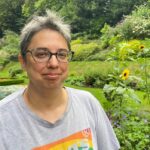 Louise Tondeur is a freelance writer, editor and tutor. After doing an MA in Creative Writing at the University of East Anglia and publishing two novels in the early noughties, she did a PhD, travelled the world, and started a family, while publishing fiction, nonfiction and poetry.
Louise Tondeur is a freelance writer, editor and tutor. After doing an MA in Creative Writing at the University of East Anglia and publishing two novels in the early noughties, she did a PhD, travelled the world, and started a family, while publishing fiction, nonfiction and poetry.
You may also like...
Read ‘Anchor’ by YA novelist Els Beerten
‘Let corners and edges scour. Let the restlessness blow and bang. We shall not be overcome.’

7th September 2022
Read ‘St. Gregory’s’ by journalist Soobin Kim
‘The delight of the utterly useless’

6th September 2022
Translating Tagore in Norwich
‘The timekeepers of this city have perhaps witnessed a passer-by cosplaying as a poet before.’

15th June 2022



